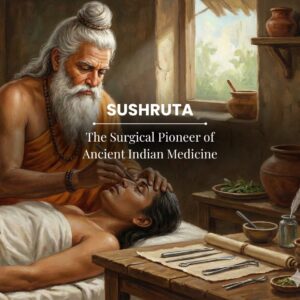Are you looking for Sciatica treatment in Ayurveda? Do you feel discomfort in your lower back that radiates down into your hips and legs? In that case, you are not alone. Up to 40% of adults experience it at some point in their lives.
Sciatica pain can occasionally flare up and go away. If a flare-up is severe or lasts more than a week, it affects your day-to-day activities.
What is Sciatica?
Sciatica refers to pain that starts in the lower back and radiates through buttocks and down the legs. It occurs when the nerve root in the lumbar spine is compressed. Typically, sciatica affects only one side of the body at a time.
Although each person’s experience is different, sciatica usually affects the legs, feet, back, and butt. Symptoms may occur constantly or intermittently.
Depending on the location of sciatic nerve pain, the following are common symptoms of sciatica:
- Low back pain
- Pain in the leg that worsens when sitting
- Burning or tingling sensation in leg
- Difficulty while walking on your toes
- Numbness or loss of sensation in the foot or leg
- Persistent or severe pain on one side of the back, leg, or hip
- Loss of reflexes and difficulty in mobility
- Worsening pain with specific activities
- Muscle weakness
Although the exact cause of sciatica varies from person to person, it may be due to an injury or aging. Some of the common causes include-
- Lumbar herniated disc: The herniated disc or an overgrowth of bone typically compresses one or more spinal nerve roots that form the sciatic nerve.
- Degeneration of tissue: There are numerous ways in which degeneration of the lumbar spine’s tissues might compress or irritate the sciatic nerve roots.
- Lumbar spinal stenosis: The narrowing of the spinal canal, known as lumbar spinal stenosis. Studies indicate that sciatica in older people can often be caused by lateral recess stenosis.
- Spondylolisthesis: Spondylolisthesis is a condition in which a small stress fracture causes one vertebral body to slip forward over the other. Bilateral sciatica can result from spondylolisthesis, which is more common in younger people.
- Pregnancy: The increased growth of the uterus during pregnancy puts pressure on the sciatic nerve.
- Piriformis Syndrome: The Piriformis muscle, located in the buttocks can sometimes become tight or spasm that compress the sciatic nerve. It gets worsened by sitting for long periods or climbing stairs.
- Trauma or Injury: Accidents, falls, or sports injuries can cause damage to the spine or sciatic nerve, which may radiate down the leg.
- Infections: Spinal infections can cause inflammation and pressure on the sciatic nerve, leading to severe back pain.
Sciatica Treatment in Ayurveda at VVAC
As per Ayurvedic text, its features closely resemble the Gridhrasi which is classified as a Nanatmaja Vataja Vikara (having the involvement of one only Dosha). The pain in Gridhrasi starts in the hip and radiates towards Kati (back), thigh, Jaanu (knee), Jangha (calf), and Pada (foot). The word Gridhrasi generally suggests the patient’s stride, which resembles that of a vulture because of the patient’s radiating pain. Modern medicine has limitations in that it can only provide temporary pain relief and can have side effects when used for the long term. In Ayurveda, Gridhrasi can be effectively managed with Panchakarma procedures and oral medication.
Ayurveda treatments for sciatic pain include a set of systematic treatments. The top Sciatica treatment in Ayurveda includes Bastikarma, Siravedha, and Agnikarma along with medications consisting of natural herbs. The natural herbs have the properties of Ama Pachana, which helps in reducing inflammation of the joints, followed by Shodhana, which involves the removal of deeply deposited toxins in the body, and Brahman i.e. rejuvenation of damaged parts or cartilage.
| Sciatica Treatment in Ayurveda at VVAC | How it helps the condition |
| Snehana (Abhyantara Sneha, Bahya Sneha) | At Vrindavan Ayurveda Chikitsalayam, the Sciatica treatment in Ayurveda involves Snehana. AT VAC, Snehana is further divided into two treatments, Abhyantara Sneha and Bahya Sneha. In the Abhyantra Sneha (Internal Oleation) medicated ghee or oils are consumed to lubricate internal tissues that reduces dryness and inflammation caused due to Vata imbalance. According to a research paper published in the National Library of Medicine, external Snehana and asanas are beneficial in the Ayurvedic treatment of Sciatica. |
| Swedana (Pizhichil, Patra Pinda Sweda, Jambeera Pinda Sweda, Upnaha Swedan) | Pizhichil, Patra Pinda Sweda, Jambeera Pinda Sweda, and Upnaha Swedan are types of Swedana (Sudation Therapy) 1) Pizhichil: A continuous stream of warm medicated oil is poured over the whole body to soothe the nerves. 2) Patra Pinda Sweda: Herbal Potlis (Poultices) with medicated leaves are applied over the affected body to relieve stress and pain from that area. 3) Jambeera Pinda Sweda: A specialized treatment that uses lemon-based poultices on the affected area to reduce stiffness and inflammation. 4) Upnaha Swedan: Herbal pastes are warmed, applied, and wrapped around the affected area to manage pain. |
| Sanshodhan | According to this Ayurvedic treatment, Sanshodhan eliminates toxins from the body that are responsible for aggravating Sciatica and Vata imbalance. According to classical Ayurveda, Sanshodhan is the main detoxification treatment. |
| Basti | This medicated Enema treatment uses medicated oils and decoctions to nourish nerves and reduce inflammation in the lower back and spine. At Vrindavan Ayurveda Chikitsalayam, all the medicated oils and decoctions are freshly prepared from scratch at the in-house Kashayapura. |
| Raktamokshan | To purify blood and improve blood circulation, the bloodletting therapy is done on a person to ensure a long-term relief from Sciatica. |

Best Sciatica Treatment in Ayurveda at Vaidyaratnam Vrindavan Ayurveda Chikitsalayam
VVAC is affiliated with Vaidyaratnam with a historical background since 1941. For efficient management of chronic diseases, VVAC offers medical modalities that have been scientifically and traditionally proven. The hospital is situated in Baddi, approximately a 50-minute drive from Chandigarh.

The Ashtavaidyans (Ayurvedic physicians of Kerala and masters of the eight branches of Ayurveda) at VVAC offer specific treatment to each individual depending on body constitution. Additionally, the expert at the hospital recommends lifestyle modification, diet, yoga, herbal therapy, and even spiritual practice to restore and maintain balance of body and mind. They consider every individual as unique and the treatment is based on the defined constitution.
For personalized treatment, we have over 100 varieties of medicinal oils and 600 types of Ayurvedic medications formulated by Vaidyaratnam. The hospital has a refreshing environment of lush green area which is very effective in relieving stress and promoting recovery.
At VVAC, Ayurvedic treatments for sciatica focus on strengthening the nervous system, identifying the underlying cause of the condition, and reducing pain. A customized combination of treatments is the most effective Sciatica treatment in Ayurveda.

- Take a diet rich in whole grains, unprocessed foods, fruits, vegetables, nuts, fatty fish (such as salmon), and soluble and insoluble fiber may be effective in reducing inflammation.
- Stay away from processed meats, fries, and onion rings since they are rich in fat and cause inflammation.
- Pizzas, bread, and pasta are regarded as meals to avoid if one has sciatica because of their high gluten content, which can lead to inflammation and trouble with digestion for some individuals.
- Unhealthy lipids like trans fats are produced when vegetable oils are hydrogenated. Consuming trans fats can raise dangerously high LDL cholesterol levels, which can worsen inflammation.
- Anti-Inflammatory foods like turmeric, ginger, garlic, leafy green vegetables, berries, and many more reduce inflammation and pain in the sciatic nerve.
- Avoid Vata-Aggravating foods that are cold, dry, and light. As it can lead to increased pain and discomfort.
The diet of a health seeker coming to VVAC for their ayurvedic treatment for Sciatica will be prescribed after a thorough ayurvedic check up by our senior physicians. Speaking about our menu, it is curated thoughtfully by eminent nutritionist and wellness expert, Sangeetha Khanna.

Besides prescribed, organic, and sattvic meals, most of the ingredients for the meals are procured from VVAC’s organic farms.
Yoga Poses for Sciatica Pain Ayurvedic Treatment
The video has the following yoga asanas that are primary and simple-to-follow. They are as follows – Ardha Matsyendrasana – This asana enhances spinal flexibility and relieves nerve compression. Ardha Kapotasana – Known to stretch the hip muscles, reducing tension on the sciatic nerve. Markatasana – Gently mobilizes the spine, improving circulation and reducing stiffness. Supta Kapotasana – Opens up the lower back and hips, alleviating nerve pain. Supta Eka Pada Padangushtasana – Stretches the hamstrings and improves sciatic nerve function.
Besides these five asanas, the additional asanas are –
- Child’s Pose (Balasana)
- Half Moon Pose (Ardha Chandrasana)
- Cobra Pose (Bhujangasana)
- Locust Pose (Salabhasana)
- Knees-to-Chest Pose (Pawanmuktasana)
- Legs-Up-the-Wall pose (Viparita Karani)
- Downward-Facing Dog (Adho Mukha Svanasana)
- Pigeon Pose (Eka Pada Rajakapotasana)
- Cat-Cow Stretch (Marjaryasana-Bitilasana)
- Seated Forward Bend (Paschimottanasana)
- Bridge Pose (Setu Bandhasana)
Natural Herbs used in Sciatica Treatment in Ayurveda
- Ashwagandha (Withania somnifera): Ashwagandha is one of the most powerful Ayurvedic herbs used in sciatica as it has anti-inflammatory and rejuvenating properties. It strengthens the ligaments, back muscles and spine.
- Guggulu (Commiphora mukul): Guggulu is a potent herb with analgesic and anti-inflammatory properties that aids in improving joint flexibility and reducing pain in the lumbar region.
- Nirgundi (Vitex negundo): Nirgundi has anti-inflammatory properties and helps in reducing pain caused due to various reasons. Nirgundi oil is used for massage to reduce swelling and sprains.
- Rasana (Pluchea lanceolata): Rasana has Tikta Rasa, Kapha-Vata hara and has spasmolytic & analgesic properties. Applying Rasna powder paste or massaging the lower back with Rasna oil helps reduce pain and inflammation due to its Vata-balancing properties.
- Shallaki (Boswellia Serrata): Shallaki has anti-inflammatory and analgesic properties and reduces pain in the joints and muscles.
- Ginger (Zingiber Officinale): Consumption of Ginger reduces pain and inflammation.
- Dashamoola, Devdaru (Cedrus Deodara), Eranda (Ricinus Communis) and many more.
Natural and Effective Home Remedies to Manage Sciatica Pain
Sciatica can be quite difficult and challenging, if not dealt timely. These simple natural home remedies can help ease discomfort and manage pain. Follow the ones mentioned-below –
- Alternative Hot & Cold Therapy: If you are suffering from Sciatica pain and want relieve from this pain, use hot & cold compression indirectly on the affected area. The hot compression improves the blood circulation to that area and cold compression reduces swelling.
- Piriformis Stretch: Known as a gentle stretch, helps relieve pressure on the sciatic nerve and improve flexibility.
- Oil Massage: Use warm Dhanwantharam oil or sesame oil to massage the affected area to reduce stiffness and increase the blood circulation in that area.
- Tennis Ball Therapy: To release muscle tension in that area, a tennis ball is rolled on that area.
- Epsom Salt Bath and Turmeric Milk are two other home remedies that also help relieves discomfort, pain, or stiffness.
Q1) What is the best treatment in Ayurveda for Sciatica?
Ayurvedic treatments including Panchakarma, herbal medicines, dietary modifications and yoga are among the most effective methods of treating sciatica.
Q2) Can Ayurveda cure sciatica permanently?
Ayurvedic treatments are generally beneficial in the management of sciatica. Ayurveda aims to reduce pain, promote healing, and relieve the symptoms of sciatica. The degree of improvement depends on the person’s body type and the severity of the disease.
Q3) How long does Ayurveda take to treat Sciatica?
Ayurveda helps in providing quick relief from pain and is more beneficial and without any side effects like modern medicines. Ayurvedic treatment generally takes four to five weeks depending upon the severity of the condition.
Q4) Are Sciatica treatment in Ayurveda for everyone?
Although Ayurvedic treatments are generally safe, it is important to consult with a qualified Ayurvedic practitioner. Some products used in Sciatic Ayurvedic medicine contain minerals, metals, herbs, or other substances that may be unsafe if used improperly or without consulting a qualified professional.
Q5) Can prolonged sitting causes sciatica?
Sitting for long periods and lack of physical activity can increase the risk of sciatica. Sciatica is caused by prolonged sitting as it puts pressure on the back and vertebrae.
Q6) What are lifestyle recommendations as Sciatica treatment in Ayurveda?
Avoid prolonged sitting or standing and take frequent breaks to move around and stretch. Further, use proper techniques when lifting objects to avoid straining your back. Don’t forget to get enough rest and sleep to allow the body to heal and recover.
Q7) Can Physiotherapy help in Sciatica Treatment in Ayurveda?
Yes, physiotherapy can be a valuable addition to Ayurvedic treatment for Sciatica. Vaidyaratam Vrindavan Ayurveda Chikitsalayam has partnered with ReLiva Physiotherapy & Rehab to help health seekers suffering from Sciatica.







